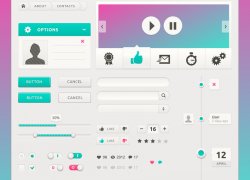"For information to be useful, it should be dynamic, searchable, and accessible." - Heather Brooke
In this ever changing world, the easiest way to grow your business is to keep updating your website, share your thoughts in social media platforms and make your contents relevant for search engine optimization (SEO). The key here is to follow change and be dynamic. Why? Because dynamic means "characterized by constant change, activity, or progress." Therefore, a dynamic website will enable you to grow much more quickly because dynamic follows the universal trend while static goes against it.
What are the differences between static and dynamic websites? What are the advantages and disadvantages for each type? In addition to the ones listed below, here are more facts from Social Presence.
Static Websites
Pros:
- Static websites are quicker to develop because it is only required to design and code the Front-End with HTML and CSS.
- Since it is quicker to develop, the cost is less expensive up front.
- It is also cheaper to host it because the only languages it uses are HTML and CSS.
Cons:
- However, static websites have a hidden cost in the long run. The extra cost is that adding and editing contents require the help of the developer every time, unless you know how to code HTML and CSS yourself for every page.
- Each page is a static .html file. If you want to make changes to the header or footer only, you would have to do that manually for every .html file to keep it consistent throughout every page. That gets very tedious in the long run when you have to manage all those files.
- The website cannot be updated by the users or clients themselves. If there is an emergency update that needs to be changed immediately, what will you do if the developer is on vacation?
- Since it requires waiting for back and forth scheduling with the developer each time you want to update, it can get frustrating for you when the developer is not available.
- Without relevant and consistent content flow, your SEO will suffer.
- When visitors of your website do not see much progress, they will start to wonder if your business is still alive.
Static websites were commonly built during the 90s and may still work for small businesses. However, if you want your business to grow and keep up with the latest web trends, I highly recommend getting a dynamic website developed. Why would you want to stay in the past and be common, when you can be different, stand out and be a flourishing company instead?
Dynamic Websites
Pros:
- Uses the latest server technologies like ASP, JSP, PHP, Python, Ruby on Rails, or MySQL. Code that is compiled on the server side runs faster than code built during the client side especially if the pages are cached.
- Dynamic websites are built where there is a separation among business logic (Back-end features and what it does), presentational design (Front-end look and feel), and contents (texts and SEO).
- With the separation, changes to the presentational design such as the header and footer can be done much more efficiently because only two template files need to be changed (usually the header.tpl.php and footer.tpl.php) instead of manually changing every .html file.
- Adding new features such as filtering contents with a dropdown menu or select options can simply be added because the Back-end code is separate from the presentational markup. Thus, the code can be managed, organized and have better code re-use for different sections of the website without affecting the ones that do not need it.
- To make it even simpler, Content Management Systems (CMS) like Drupal and WordPress were invented. This means that users can easily add new pages with only a click on a button and use WYSIWG editors like CKEditor or TinyMCE.
- Dynamic websites are built with user-friendly in mind because the contents are stored in the database.
- With the contents stored in the database, they can easily be accessed using server technologies like PHP to create useful data analysis, search filters, and categorizing.
- Automation of tasks that rarely change is also possible to lessen the user's frustrations and focus on your business.
- Additionally, it allows everyday users to create contents on your website if they have an account and help increase your followers even more.
- Categorized and relevant contents support the improvement of your website’s SEO.
Cons:
- The initial fee is more expensive because the development time requires gathering functional details from the client to make the website flexible in the future.
- Dynamic websites require a better server than a low-cost host to handle all the dynamic data and traffic that your thriving website will eventually receive.
Dynamic websites make up the cool web applications that exist in the world today: E-commerce, Twitter, Facebook, and any forms of social networking websites. It also creates a professional and engaging experience that shows you care about where your business is heading and are willing to improve the way you communicate with your customers now and in the future.





